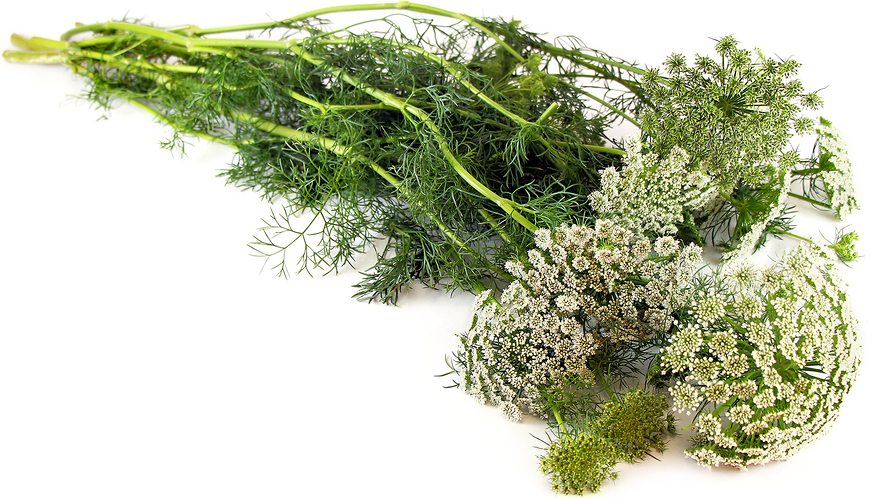


Wild Carrot (Queen Annes Lace)
Estimated Inventory, bunch : 0
Description/Taste
Wild carrot is an ancestor of the domesticated carrot and features a delicate and ornate floral structure. It has a compound array of tiny white flowers, arranged in lacy, flat-topped clusters typically 7.5 to 10 centimeters wide, with a distinctive dark purple center. These clusters sit atop a hairy, ribbed green stem that can reach up to one meter in height. Its green leaves are divided into multiple narrow segments that give the plant a lacy, fern-like appearance. As Wild carrot matures, the umbel of it fruit curls inward, forming a bird's nest shape that turns brown as the seeds ripen. Each flower stalk ends with a small bristly seed, the fruit of the plant. The root is white, carrot-scented, and ranges from 5 to 20 centimeters in length, while the edible leaves offer a strong, chewy flavor reminiscent of carrots yet spicier and crunchier.
Seasons/Availability
Wild carrot is harvested from late summer to early fall.
Current Facts
Wild carrot, botanically known as Daucus carota, belongs to the Apiaceae family, commonly known as the parsley family. Wild carrot is also known as Bee's Nest-Plant, Devil’s Plague, and Bird's-Nest. The name "Bird's-Nest" comes from its mature form, where the flower cluster curls inward, resembling a bird's nest. The most popular name for Wild carrot is Queen Anne's Lace. This is thought to stem from the lacy patterns of its flower head, with a central purple flower representing Queen Anne's blood from a pricking incident while making lace. It could also be named after Saint Anne, the patron saint of lace-makers. This plant is entirely edible and has significant herbal medicinal uses, with some claiming it has aphrodisiac properties. However, caution is advised when foraging due to its resemblance to toxic plants like poison hemlock, particularly in leaf shape and division. Wild Carrot’s foliage and roots suport various insects, including the Carrot Beetle and the larvae of Black Swallowtail butterfly and Carrot Seed Moths.
Nutritional Value
Wild carrot is rich in vitamin A, which is essential for good vision, immune function, and skin health. Its root contains dietary fiber, which aids in digestion and maintaining healthy cholesterol levels. Wild carrot contains falcarinol, an antioxidant that may inhibit cancer cell growth, especially in colon and blood cancers. Wild carrot seeds have been traditionally used for their diuretic and stimulant properties, helping to increase urine production and boost energy levels. The roots are valued in herbal medicine, particularly for treating jaundice, a condition characterized by yellowing of the skin due to liver dysfunction, and for expelling threadworms in the digestive tract. Because it was historically used as a contraceptive and can cause allergic reactions, Wild carrot is best avoided during pregnancy and by those sensitive to celery or chrysanthemums.
Applications
Every part of the Wild carrot—roots, leaves, flowers, and seeds—is edible. The roots can be stringy and spicy when raw so they are often preferred cooked, diced up into soups and stews, dried, pickled, or ground into a powder as a coffee substitute. The flowers can be fried, steeped into herbal tea, or mixed as a flavoring for syrups and vinegars. The leaves impart a herbal carrot flavor to stocks and soups. Wild carrot seeds can be dried and used as a spice to enhance carrot cake, salads, crème brûlée, pastries, and cocktails. Wild carrot is complemented by flavors such as dill, parsley, thyme, coriander, garlic, onion, citrus, butter, olive oil, honey, and maple syrup. To harvest the seeds, dry the flower clusters, then grind the fruits to release their intense fragrance.
Ethnic/Cultural Info
Wild carrots are believed to have originated from Afghanistan and spread to Mediterranean Europe before the Christian era. Known for its diuretic properties and potential metabolic benefits, Wild carrot was introduced to North America by Europeans. Recognizing these qualities, the Mohegan Native Americans began steeping the flowers in tea as a treatment to manage symptoms associated with diabetes. Early English herbalists believed that the tiny, purple, central flowers of Wild carrot could also serve as an aphrodisiac since libido-boosting properties were commonly ascribed to plants that were rare or unusual in appearance.
Geography/History
Wild carrots are native to Europe, Eastern Asia, and northern Africa. They thrive in dry sunny climates and are commonly found in disturbed sites like roadsides, meadows, and pastures, as well as woodland edges. When Wild carrots were introduced to North America as a medicinal herb, they gained popularity and gradually naturalized across the continent. This increased interest led to the development and widespread cultivation of the larger, tastier domestic carrot we commonly find in grocery stores today. Due to its ability to adapt to so many types of environments, Wild carrot plants took over and became an invasive weed in many states. Wild carrots are rarely found in grocery stores or gardens and are more often sourced from the wild.
Recipe Ideas
Recipes that include Wild Carrot (Queen Annes Lace). One
| Its Not the Destination |
|
Queen Anne's Lace Jelly |
| Eat the Weeds |
|
Queen Anne's Lace Jelly |




